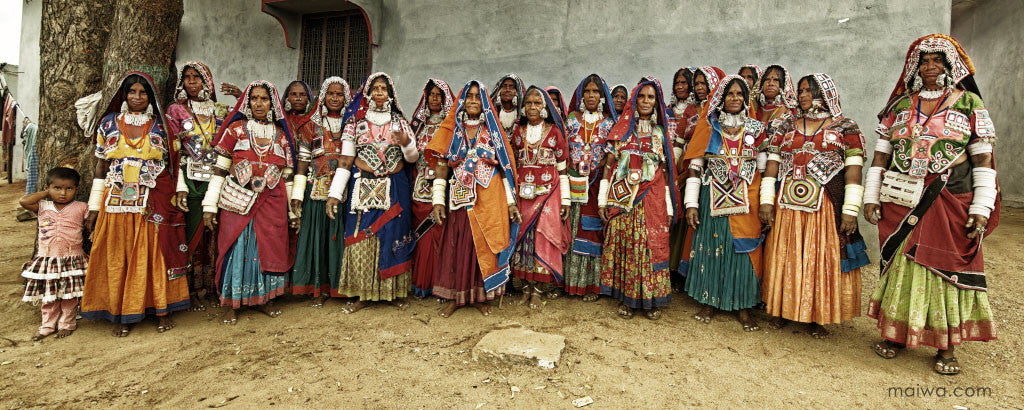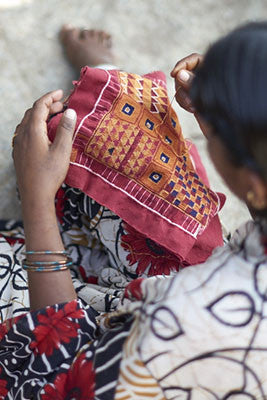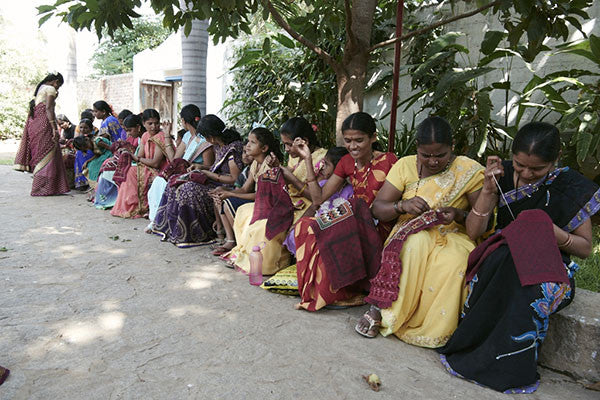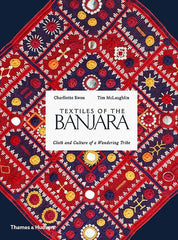
The Banjara embroider like who they are. The designs are bold and immediate.
India is a country known for its cultural diversity and the dramatic appearance of its many ethnic groups. Yet even here, one group stands apart for its traditional costume and the forceful presence of its members: these are the Banjara, a semi-nomadic group who maintain a distinct, self-contained, identity.


For several centuries the Banjara deployed long-distance supply caravans through areas where there were neither roads nor railways. During the Mughal era their lines of loaded animals reached an astonishing size. At the their height of their power droves of 180,000 pack bullocks were commanded by a single Naik (Banjara chief).
The group is under considerable pressure to assimilate with modern India and abandon traditional ways. The Banjara women, however, are mostly holding to their ancient mode of dress, which is perhaps the most colorful and elaborate of any tribal group in India. It is their dress and jewelry that sets them apart from all others.
Their full-length skirt is often red with borders embroidered in mustard and green thread. The odhni (mantle) which covers the head is long enough to drape down their backs almost touching the feet. As with much embroidery which originates in the desert regions of Rajasthan, it is elaborately embroidered and studded with mirrors. A variety of materials - silver, brass, some gold, cowries, ivory, animal bone and even plastic - are used in the making of a Banjara wardrobe. Heavy silver ornaments are conspicuous. The numerous cowries that the Banjara tribal women wear are very auspicious as they represent Lakshmi, the Goddess of prosperity.
The Banjara embroider like who they are. The designs are bold and immediate. The lines and shapes have strength of personality that permits them to wander over the surface of a work without diminishing their distinctive character. Stitchwork alludes to symmetry without being symmetric and manages to incorporate geometric principles only loosely. Embroideries by tribal groups in India’s Kutch Desert often display an exact, jewel-like quality, but this quality is entirely absent from Banjara work. Banjara embroideries, like the Banjara themselves, are almost instantly identifiable to those who are familiar with them, even though few criteria can be held up as definitive.
 Interested to know more? Charllotte Kwon and Tim McLaughlin have written a book documenting Banjara culture and history, stitches and textile designs. This large-format hardcover book was published by Thames and Hudson in 2016. It is available in the Maiwa stores or online here.
Interested to know more? Charllotte Kwon and Tim McLaughlin have written a book documenting Banjara culture and history, stitches and textile designs. This large-format hardcover book was published by Thames and Hudson in 2016. It is available in the Maiwa stores or online here.
In late 2016 Charllotte, Tim, and Maiwa staff made a five-week trip to distribute copies of the book to the women who were instrumental in helping bring it to life. See Maiwa giving out the book below.

The Banjara embroider like who they are. The designs are bold and immediate.


 Interested to know more? Charllotte Kwon and Tim McLaughlin have written a book documenting Banjara culture and history, stitches and textile designs. This large-format hardcover book was published by Thames and Hudson in 2016. It is available in the Maiwa stores or online here.
Interested to know more? Charllotte Kwon and Tim McLaughlin have written a book documenting Banjara culture and history, stitches and textile designs. This large-format hardcover book was published by Thames and Hudson in 2016. It is available in the Maiwa stores or online here.